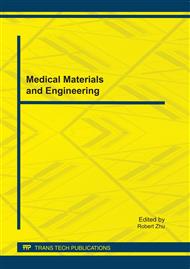[1]
X.M. Chen, Y.Q. Chen, H. Zhang, et al, Lac insect Cultivation and Lac Processing, China Forestry Press, Beijing,2008.
Google Scholar
[2]
H. Zhang, G.G. Fang, H. Zheng, et al, Study on the stability of lac dye, Food Sci. 30 (23) (2009) 65-69.
Google Scholar
[3]
K. Piyarat, M. Walaisiri, Pornpen W, UV spectroscopic characterization and stabilities of natural colorants from Roselle Calyx, Lac Resin and Gardenia Fruit, J. Heal. Res. 24 (1) (2010) 7-13.
Google Scholar
[4]
T Eizo, H. M Timothy, W Toshiro, et al. Preventive effects of anthraquinone food pigments on the DNA damage induced by carcinogens in Drosophila, Mutation Res., 480(2001) 139–145.
DOI: 10.1016/s0027-5107(01)00177-4
Google Scholar
[5]
C. Anthony, Comprehensive focus on natural dyes, Colour Cosmetics, (9) (2009) 57-69.
Google Scholar
[6]
C, Montra, R Saowanee, B. B John, et al. An Adsorption and Kinetic Study of Lac Dyeing on Silk, Dyes and Pigments, 64 (2005) 231-241.
DOI: 10.1016/j.dyepig.2004.06.009
Google Scholar
[7]
C. Montra, R. Saowanee, B. B John, et al. Adsorption Kinetic Study of Lac Dyeing on Cotton, Dyes and Pigments, 76 (2008) 435-439.
DOI: 10.1016/j.dyepig.2006.09.008
Google Scholar
[8]
Q.T. Meng. The Application of Savageness Food Coloring Matters or Wool Dyein, Tianjin University of Technology, Tianjin (2007).
Google Scholar
[9]
J.J. Fu, The UV-protection of Lac dye and its Application to Silk, Suzhou University, Suzhou (2008).
Google Scholar
[10]
Y.M. Lu, M.C. Zhou, H. Zheng, et al, Characteristics and Research Progress of Quinone Pigments, Chemistry and Industry of Forest Products, ,27(S) (2007)147-152.
Google Scholar
[11]
G.T. Ling, Food Additive Manual. 3rd ed, Chemical industry press, Beijing (2003).
Google Scholar
[12]
GB 2760-2011 The national food safety standards Use of food additives standards, Health Ministry of China, Beijing, (2011).
Google Scholar
[13]
M Alan, Carotenoids and Other Pigments as Natural Colorants, Pure Appl. Chem., 78(8) (2006) 1477–1491.
DOI: 10.1351/pac200678081477
Google Scholar
[14]
H. Zhang, G.G. Fang, H. Zheng, Study on Ultrasonic Wave Assisted Extraction of Lac Dye, Food Science, 31(20) (2010) 116-120.
Google Scholar
[15]
H. Zhang, G.G. Fang, H. Zheng, et al, Study on Purification Process of Lac Dye Red by Macroporous Resins, Food Science, 31(22) (2010) 232~236.
Google Scholar
[16]
H. Zhang, H. Zheng, J. Chen, et al, Chinese Patent ZL200810004318.1, (2008).
Google Scholar
[17]
X.N. Hou, X.R. Wang, L. Ding, et al, Study on the Dyeing Behavior of Lac Dye on Silk, Textile Auxiliaries, 26(2) (2009) 16-19.
Google Scholar
[18]
Y. Lu, Anthraquinone Chemical, Chemical Industry Press, Beijing (2009).
Google Scholar
[19]
J. Rao, J. Xie, J.Q. Zhao, et al, Free Radical and Singlet Oxygen Produce by Chrysophanol Photosensitization. Science in China Ser. B Chemistry, 34 (3) (2004) 211-217.
Google Scholar
[20]
Z.Y. Luo, X. Huang, G.R. Bao, et al, Study on the Scavenging Effects of the Free Anthraquinones from Rheum Palmatum Superoxide Anion Radical. Strait Pharmaceutical, 21(12) (2009) 43-45.
Google Scholar
[21]
L.Y. Huang, X.H. Lin, W. Chen, et al, Study of Aloe-emodin and Emodin Scavenging Oxy-free Radicals, Chinese Journal of Hospital Pharmacy, 26(1) (2006) 12-14.
Google Scholar
[22]
J.C. Liu, Z.G. Jiao, Y. Zhang, et al, Scavenging effects of Sweet Cherry Red Pigment on Free Radicals and Nitroso. Food Industry Science and Technology, 29(11) (2008) 122-124.
Google Scholar
[23]
J.S. Li, D.Y. Jia, K. Yao, et al, In Vitro Radical-Scavenging Activity of Polysaccharides from Eleocharis tuberosa Peels. Amino Acids and Biological Resources, 30(4) (2008) 7-9.
Google Scholar
[24]
N. Ren, L.P. Guo, Y.H. Liu, et al, Radical Scavenging Activity of Grape Wines Made in China, Food Science, 30(15) (2009) 90-93.
Google Scholar


